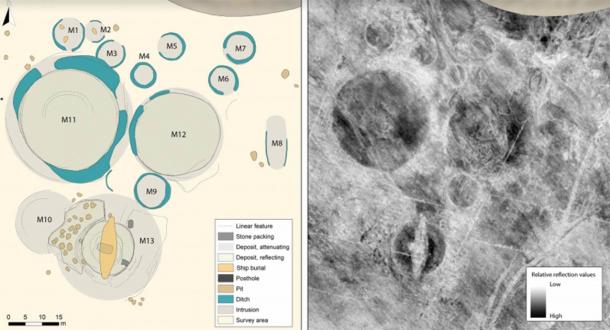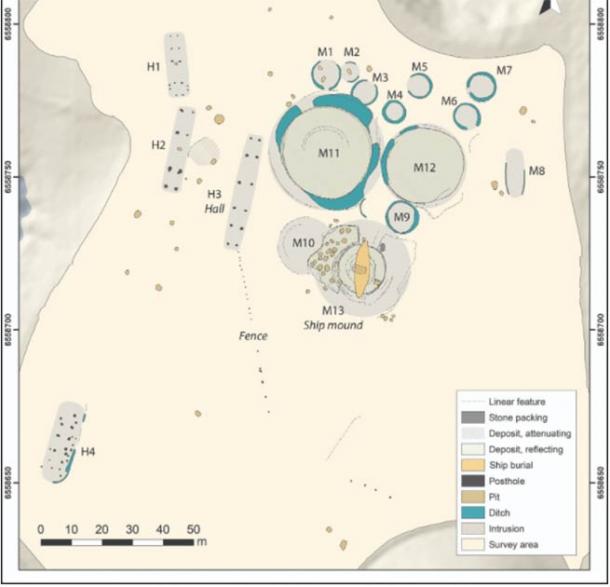Archaeologists in Norway have made an amazing discovery without even digging. Using breakthrough radar technology, they have found an elite settlement and burial ground from the Nordic Iron Age (550-1050 AD). Initially the most significant find at the site was a rare Viking ship burial, the first in decades. But now, in addition to this, archaeologists have located a “possible” Nordic center of religion or politics at the same location. This site is providing insights into the evolution of Nordic society as it transitioned from the Iron to the Viking Age. The remarkable archaeological complex was found near the Jell Mound in Gjellestad, Østfold, in southern Norway and is described in a journal report published by Antiquity.
The Norwegian site is one of the biggest burial mounds from the Iron Age and it has previously yielded a treasure trove of artifacts. The owner of the land applied for permission to put a drainage ditch on his land. In accordance with Norwegian law, archaeologists surveyed the area to ensure that the ditch would not damage anything of historical importance.

Gold pendant: a so-called “berloque” found by metal-detectorists near the Jell Mound (© 2020 Kirsten Helgeland, Museum of Cultural History, University of Oslo/CC BY-SA 4.0 / Antiquity Publications Ltd ).
Viking Burials And Much More Found With Radar!
Some trail trenching and metal detecting was carried out at the site and this prompted Norwegian experts to use ground-penetrating radar ( GPR), which was employed to map features below the surface. “The initial results announced in 2018, revealed that the seemingly non-descript field next to the Jell Mound was actually home to a significant archaeological site,” the research team wrote in an Antiquity press release. The GPR technology collected data from the site and allowed the archaeologists to map the area underground the surface of the field. In effect, the archaeologists could see what was below the ground without having to dig into the earth.
The archaeologists knew that three funeral mounds had once been at the site and that they had been ploughed under in the 19 th century AD, but it turns out that there was much more to find. The GPR survey revealed anomalies and evidence for post holes and hearths and this allowed the researchers to develop a picture of what lay beneath the soil. In the Antiquity journal report, the experts wrote that “The GPR showed 13 burial mounds once existed at Gjellestad, some over 30 meters wide [98 feet wide].”

Left image: The interpretation map of the mound cemetery based on the full depth-range of the GPR dataset; Right image: The corresponding depth slices from the depth-range 0.3-0.8 meters below the surface. (Source: © Kartverket/CC-BY-4.0; figure by L. Gustavsen/ Antiquity Publications Ltd ).
Iron Age Viking Center
Most of the mounds are burials because they are circled by ring ditches and it seemed that they were used over centuries during the Iron Age . It is believed that there were also four longhouses at the site. Some of the buildings that were discovered were exceptionally large: up to 30 meters long (90 feet long). It seems likely that they were feasting halls, religious structures, or possibly cult centers where rituals and initiation ceremonies used in the Viking religion took place.
Lars Gustavsen, lead author of the research report, informed Ancient Origins in an email that a large building found at the site could have had political “functions such as representation and the maintenance of social and political alliances.”
However, the mound known as M13 proved to be something really special. In it, they found some anomalies including “a large, elliptical anomaly that we interpret as a ship grave,” the researchers wrote in Antiquity. They had identified a ship that had been placed in the mound, as part of a burial ritual. In the interview with Ancient Origins, Lars Gustavsen said that: “the person buried could have been a man or a woman, someone rich or a slave, or perhaps there was no one buried in the ship.”

Combined interpretation map of the Gjellestad site based on the geophysical survey. (Source: © Kartverket/CC-BY-4.0; figure by L. Gustavsen / Antiquity Publications Ltd )
Mysterious Burial Area Was Further Analyzed
Based on the measurement of the features of the anomaly, the data suggests “an original length of approximately 22m [72 feet]” according to the authors. The discovery of a Viking ship burial is an astonishing find. Very few have been uncovered in the last 100 years.
It is believed that the vessel was a sailboat rather than a rowboat. Also found in the mound with the Viking ship was a mysterious anomaly about which the researchers said, “for the moment we interpret it as a later intrusion into the mound.”
It is believed that the Viking ship burial tradition originated in what is now modern Sweden in the first century AD. Research shows that elites in Norway adopted the practice possibly because of interactions with royalty in England . Several hundred boat burials have been found over a wide area of northern Europe. Based on similar finds, they believe that the most recent Norwegian Viking ship burial dates to the 10 th century AD, the highpoint of the Viking Age .
Iron Age Center Of Power
In the Antiquity press release, Mr Gustavsen stated that “The site seems to have belonged to the very top echelon of the Iron Age elite of the area.” And it is similar to other sites found elsewhere in the region. It appears that it originated as a common burial mound that later became a burial ground for the elite, with the halls and the Viking ship burial added later. In an email to Ancient Origins the lead author stated that it was “A site where political and societal influence was displayed and maintained, and from which political and societal control could be exerted.”
The structures and the mounds would also have been used for political purposes. This was a turbulent age in southern Scandinavia when rival group fought for scarce arable land. According to Antiquity the “the emergence of Gjellestad must be considered—as a clear statement by a community reinforcing its ties to the landscape.” There is evidence that the Viking ship burial would have been seen for miles and it would have been a statement by the community that they owned the land.
The site’s location probably meant that it was also a trade center. Mr Gustavsen told Ancient Origins that given its location near the shore, it is likely that “sea-borne trade would have been important for the development of the site.” Test excavations were carried out in 2019 at the Gjlellestad site by Norwegian archaeologists. A full excavation of the Viking ship burial is expected to take place shortly. The researchers also anticipate that the excavations will reveal harbor facilities at the site.
The full report, “Gjellestad: a newly discovered ‘central place’ in south-east Norway” by Lars Gustavsen will be published 11-11-2020, DOI: 10.15184/aqy.2020.39
Top image: The Viking ship burial at Gjellestad is now known to be part of a larger mound cemetery and settlement site from the Iron Age, located next to Norway’s monumental Jell Mound. Source: Lars Gustavsen / NIKU
By Ed Whelan
 RSS Feed
RSS Feed















 November 11th, 2020
November 11th, 2020  Awake Goy
Awake Goy  Posted in
Posted in  Tags:
Tags: 













